
* In the mid-1930s, the Fieseler aircraft company of Germany began work on a light support aircraft for the German Army, which emerged as the "Fi 156 Storch (Stork), and featured remarkable short take-off / landing (STOL) capabilities. The Storch was built in good quantities, and provided excellent service through the war, as well as in the postwar period.
In the 1950s, the Pilatus company of Stans, Switzerland, came up with a STOL utility aircraft, the "PC-6 Porter", along the lines of the Storch. The Porter was built in piston and turboprop versions, and also proved popular. This document provides a history and description of the Storch and the Porter -- as well as the US-made "Helio Courier", another STOL utility aircraft along the lines of the Storch.
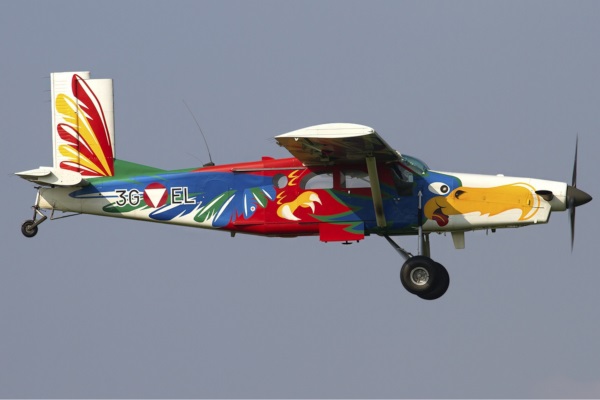
* In 1935, the German Reichsluftfahrtministerium (RLM / Reich Aviation Ministry) initiated a competition for a new light army support aircraft that would be useful for liaison, army cooperation (or forward air control in modern terms), and air ambulance duties. Entries were submitted by the Messerchmitt, Siebel, and Fieseler companies, with the Fieseler "Fi 156" selected as the winner, largely on the basis of its outstanding short-field ("short take-off / landing" or STOL, in modern terms) capabilities. Five prototypes ("Versuchs") were built from 1935 to 1937, including:
Ten "Fi 156 A-0" preproduction machines were built in 1937 & 1938, leading to the first production model, the "Fi 156 A-1", introduced in 1938. It was given the name "Storch (Stork)".
The Fi 156 was designed by a team under Fieseler's chief designer Reinhold Mewes and technical director Erich Bachem. It was a high-wing aircraft with fixed taildragger landing gear, being of mixed construction: fuselage with a steel-tube frame and fabric covering, two-spar wings with wood frames and fabric covering, and wood-framed tail surfaces with plywood sheathing. The Fi 156 A-1 was powered by an Argus A-10C air-cooled inverted inline vee-8 engine, max power rating being 180 kW (240 HP), driving an adjustable two-blade metal propeller. There were fuel tanks in the wing roots, with a total capacity of 145 liters (38 US gallons).
The high rectangular wing featured twin bracing struts on each side, a fixed leading-edge slat, with each rear wing featuring inboard flaps and outboard ailerons of roughly equal size. The ailerons drooped along with the flaps when the flaps were extended, with the ailerons having large trim tabs. All control surfaces were manually actuated -- including the flaps, which were deployed by a hand crank. The wings could be hinged back along the fuselage for stowage and transport. The tailplane had single braces topside.
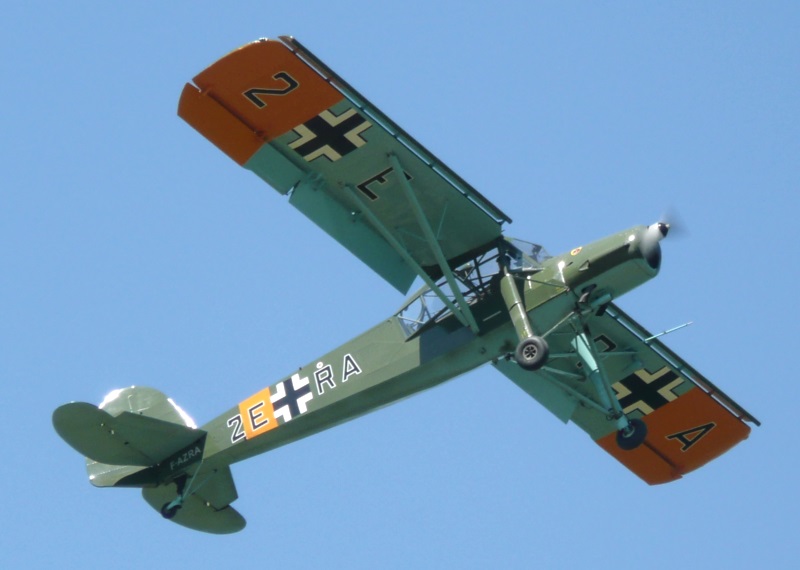
The main landing gear was tripod-mounted and heavily shock-absorbed, being intended for drop-down landings. Some models of the Storch could be fitted with skis for winter operations. There were three seats in series. The side windows slanted outward, to give the occupants a downward view. There was a single front-hinged door on the right. While the STOL capability of the Storch was impressive, thanks to its cluttered aerodynamics, it was tiring and not so easy to fly.
* Only 16 Fi 156 A-1 machines were built -- some sources claim only six were actually completed. The A-1 was followed by improved variants:
Sweden obtained a number of C-1s as the "Fi 156 K-1". There was also the "Fi 156 F" and "Fi 156 P" counter-insurgency variants, being the C-3 with a light machine gun in a window on each side and stores racks; plus the "Fi 156 U" anti-submarine variant, carrying depth charges. These appear to have been experimental only and did not see action.
___________________________________________________________________
FIESELER FI 156 C-2 STORCH
___________________________________________________________________
wingspan:
14.25 meters (46 feet 9 inches)
wing area:
26 sq_meters (280 sq_feet)
length:
9.91 meters (32 feet 6 inches)
height:
3.05 meters (10 feet)
empty weight:
930 kilograms (2,050 pounds)
normal loaded weight:
1,324 kilograms (2,920 pounds)
max speed, sea level:
175 KPH (109 MPH / 95 KT)
cruise speed:
130 KPH (80 MPH / 70 KT)
service ceiling:
4,600 meters (15,090 feet)
range:
390 kilometers (240 miles / 210 NMI
___________________________________________________________________
The Soviet Union obtained at least one Storch during the "friendship of thieves" period of 1939:1941, when the German Reich and the USSR were pretending to be allies. The Soviets liked it very much, with Soviet aircraft designer Oleg Antonov redesigning it, making it heavier and more capable, with production set up in a factory in Estonia. It was powered by a six-cylinder inverted-inline air-cooled engine. At least one prototype of the "OKA-38 Aist (Stork)", as the Soviet version was known, was flown, but the German invasion of the USSR in the summer of 1941 put a halt to plans for production.
The Storch was a popular staff transport, one being used by Field Marshal Erwin Rommel, head of the Afrika Korps. A number of senior British officers, including Field Marshal Bernard Law Montgomery, used captured examples, with one of them borrowed by British Prime Minister Winston Churchill. Possibly the most famous exploit of the Storch was Operation EICHE, the 1943 rescue of deposed Italian dictator Benito Mussolini from the mountaintop enclave where he was being held prisoner. German commandos flew in on gliders, secured the enclave, and flew Mussolini out on a Storch. At the end of the war, well-known test pilot Hanna Reitsch flew Field Marshal Robert Ritter von Greim into Berlin's Tiergarten while the city was under siege. Adolf Hitler was asked if he wanted to fly out, but he decided to stay.
About 2,900 Fi 156s, mostly C variants, were produced from 1937 to 1945. Most production was at the Fieseler Factory in Kassel, though production was begun at the Morane Saulnier factor at Puteaux, France, in 1942. In 1943, other demands on production at the Kassel plant led to transfer of production to Czechoslovakia. Czech production is complicated:
By the end of the conflict, 2,867 Storches had been built, with 1,908 produced at Kassel, 784 in France, and 151 in Czechoslovakia. They served with most of Germany's allies.
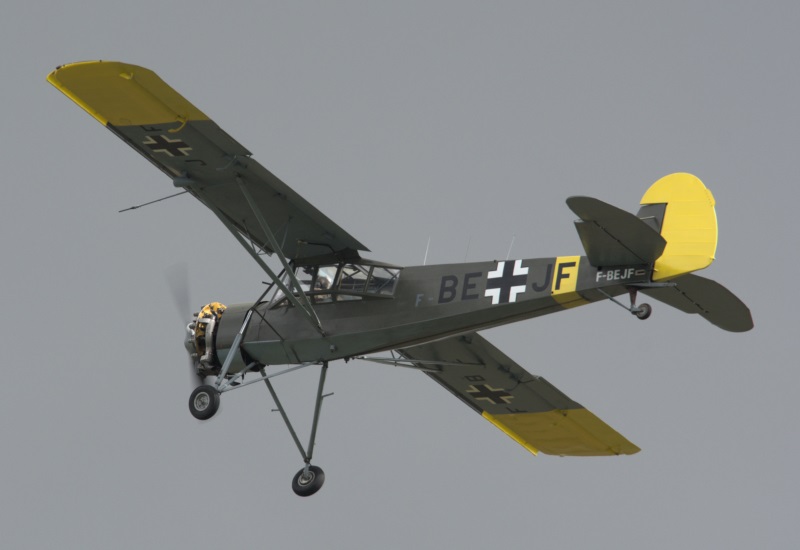
After the liberation of France, Morane-Saulnier continued production of the Storch, with machines built to German specification being designated "MS.500 Criquet (Cricket)". Morane-Saulnier went on to build their own refinements, without the rear gun, and some machines having metal wings. The Criquet variants included:
French manufacture of the Storch continued to 1965, with the numbers of postwar production given as 764 aircraft. Production also continued to 1949 at the Mraz factory, with machines designated "K-65 Cap", such machines serving with the Czechoslovak Air Force. Sources also mention that Storch production by the ICAR factory in Bucharest, Romania, with 16 built during the war -- though bombings of the factory suggest that none of them may have been delivered. 64 were built into 1946.
Storches remained in service for decades after the war, Criquets seeing action in with the French in Indochina and Algeria. Other countries that flew the Storch in military or paramilitary service in the postwar period included Cambodia, Egypt, Greece, Laos, Morocco, Norway, Poland, South Vietnam, and Yugoslavia.

In civil service, they served in a variety of roles, including search and rescue, plus agricultural spraying. Many have survived and some are still flying. A number of small firms also offer subscale flying replicas, such as the Slepcev Storch, three-quarters the size of the original.
BACK_TO_TOP* In the mid-1950s, the Pilatus company of Stans, Switzerland, began work on a single-engine short take-off / landing (STOL) utility aircraft, with the first prototype of the "PC-6 Porter" performing its initial flight on 4 May 1959. The initial prototype was powered by a piston engine with 255 kW (340 SHP), leading to the initial flight of the turboprop-powered "Turbo Porter" on 2 May 1961, fitted with a Turbomeca Astazou II engine.
As it emerged, the PC-6 was an all-metal high-wing aircraft with fixed taildragger landing gear, built strong, featuring excellent short / rough field performance, featuring low-pressure tires and shock-absorbed landing gear. It was configured for single-pilot operation, though a second set of controls was an option. It could be fitted with skis or floats.
The PC-6 had a flat floor with tie-downs, and could be fitted with six removeable passenger seats, or ten in a high-density configuration. The seats could be folded up and in a compartment behind of the cabin. Cargo load was up to a tonne (2,200 pounds). The cabin had ventilation, heating, and soundproofing, but was not pressurized. There was typically a double-width sliding door on the right, a double outward-opening door with center post, and forward-hinged doors on each side of the cockpit. There was also an option for a floor trapdoor, for imagers or dropping kit by parachute.
Other options offered over time included three auxiliary fuel tanks mounted in the rear compartment, underwing tanks, sand filters, propeller de-icing system, mudguard, tailwheel debris guard, oxygen system, and enhanced power distribution system. The PC-6 proved highly adaptable to multiple roles over its history, including utility transport, paradrop and skydiving, aerial photography, surveillance, target-towing, air medical services, search & rescue, crop-dusting, & firefighting duties.
The Astazou II turboprop engine proved unreliable, with the Turbo Porter moving on to the Garrett Air Research TPE 331, and some Astazou-powered machines were converted to TPE 331 power. From 1966, the Pratt & Whitney Canada (PWC) PT6A turboprop became the preferred engine -- driving a three-bladed or four-bladed variable-pitch reversible prop. Over two-thirds of all PC-6s built had the PT6A engine, or were refitted with it.
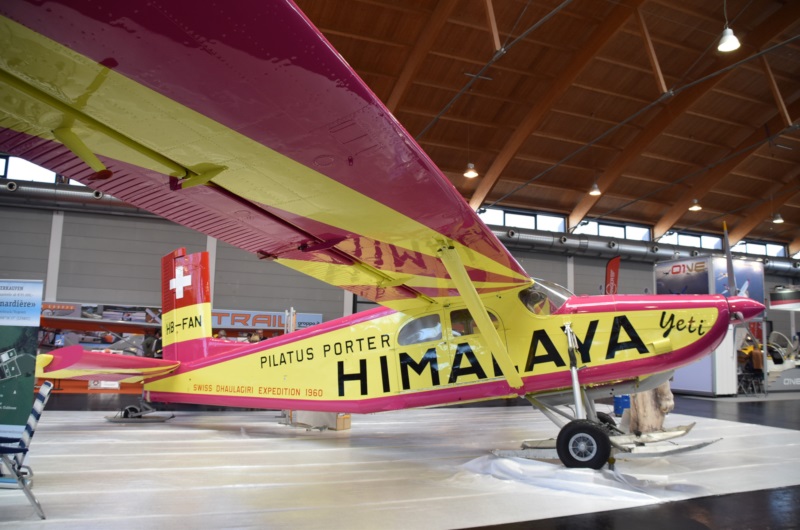
The various engine options more or less defined the PC-6 variant series. The piston-powered Porters included:
As noted, the Turbo Porter was much more popular than the piston Porter. Turboprop-powered PC-6 variants included:

Advanced-technology features such as autopilot, radar, and imaging turrets were introduced along the line. Late production Turbo Porters were fitted with Garmin glass cockpits, with a number of earlier machines retrofitted with them.
___________________________________________________________________
PILATUS PC-6 B2-H2 TURBO-PORTER:
___________________________________________________________________
wingspan:
15.87 meters (52 feet 1 inch)
wing area:
30.15 sq_meters (324.5 sq_feet)
length:
11 meters (36 feet 1 inch)
height:
3.2 meters (10 feet 6 inches)
empty weight:
1,270 kilograms (2,800 pounds)
payload weight:
1,130 kilograms (2,490 pounds)
MTO weight:
2,800 kilograms (6,175 pounds)
max speed:
230 KPH (145 MPH / 125 KT)
cruise speed:
215 KPH (130 MPH / 115 KT)
service ceiling:
8,195 meters (25,000 feet)
range, max payload:
730 kilometers (455 MI / 395 NMI)
ferry range:
1,620 kilometers (1,000 MI / 870 NMI)
___________________________________________________________________
Along with the PC-6 variants, there was also a single "PC-8D Twin Porter" with dual Lycoming IO-540-G1B5 engines, with 215 kW (290 HP) each. One prototype was built, flying in 1967, but it did not enter production. There was talk of a version with twin turboprops instead of Lycomings, and various concepts for an enlarged "PC-10" turboprop transport, but none of them happened.
In addition to production in Stans, the Turbo Porter was built under license by Fairchild-Hiller of the USA, with about a hundred built. Turbo Porters were also rolled out from the Letov Kbeley plant in the Czech Republic from 1993, with a collaborative production effort set up in Chongqing, China, from 2013. The Chongqing plant at least built fuselages, which were shipped back to Stans for completion. It is not clear if complete aircraft were ever built in China, though the Turbo Porter did prove popular with Chinese buyers.
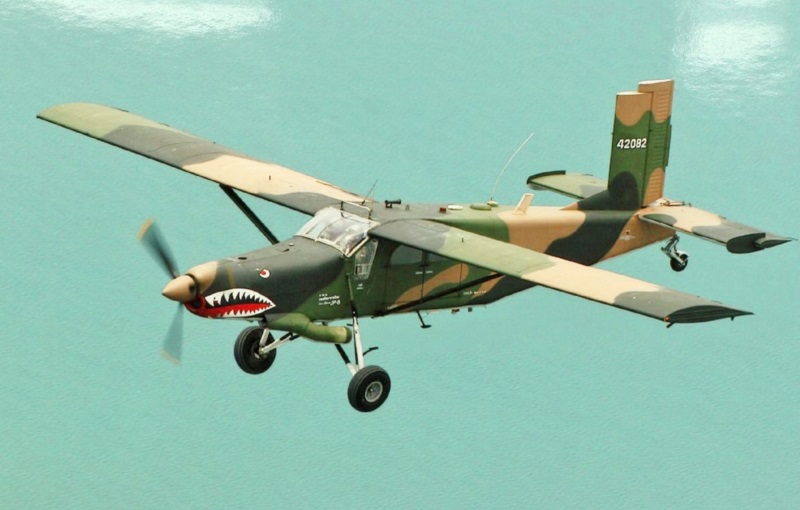
A number of Fairchild-Hiller PC-6s were obtained by the US military during the Vietnam War -- being designated "AU-23A Peacemaker" when in service with the US Air Force, and the "UV-20 Chiricahua" when in service with the US Army. The AU-23A, the "AU" meaning "Attack / Utility", was configured as a gunship, featuring a side-firing three-barreled 20-millimeter XM-197 Gatling-type cannon, two stores pylons under each wing, and a centerline stores attachment. However, it did not prove satisfactory in combat service, the aircraft being handed to the Thais after only a year. The Army UV-20s, being utility machines, proved more enduring, serving into the 1980s. The CIA also used up to 23 PC-6s, particularly during the Vietnam War, flying under the agency's "Air America" front operation. The Austrian Air Force flew a dozen PC-6s from 1976.

The last of 604 PC-6s was delivered in 2022. Along with the US Army and Air Force, military operators of the PC-6 have included Algeria, Angola, Argentina, Australia, Austria, Bolivia, Burma (Myanmar), Chad, Colombia, France, Ecuador, Iran, Israel, Mexico, Nepal, Oman, Peru, Slovenia, South Africa, Sudan, Switzerland, Thailand, and the United Arab Emirates, and the USA. They have been flown by police / government operators in Malaysia, Oman, South Africa, and Thailand, and have had civil operators all over the world.
BACK_TO_TOP* As a footnote, the USA built its own rough equivalent to the PC-6, named the "Helio Courier" -- a product of the Helio Aircraft Company, which was founded in Massachusetts in 1948 by Massachusetts Institute of Technology (MIT) professor Otto Koppen and Harvard University professor Lynn Bollinger.
Koppen and Bollinger wanted to build a very safe, stall-proof utility aircraft, with STOL capability and rough-field operation being secondary objectives. They extensively modified a Piper PA-15 Vagabond to come up with a two-seat demonstrator, the "Helioplane", with initial flight in 1949. The demonstrator evolved over the next few years into the four-seat "H-291 Helio Four", which entered production as the "Helio H-391 Courier" in 1954, being built at a plant in Pittsburgh, Kansas. A series of refined variants -- ignoring subvariants -- followed, including the "H-392", "H-395 Super Courier", and ultimately the "H-295 Super Courier", introduced in the mid-1960s.
The Courier variants differed in engine, seating, and airframe tweaks, though it's hard to reliably nail down the precise details for any of them but the definitive H-295. It was a high-wing aircraft with fixed taildragger landing gear, featuring primarily metal construction. The single-spar wing featured a full-width automatic slat on the leading edge, electrically-operated one-piece flaps across 74% of the trailing edge, with fabric-covered ailerons outboard. The tailfin was noticeably tall, with a manually-actuated rudder and, unusually for a light aircraft, an all-moving tailplane. The landing gear was heavily shock-absorbed; the Courier could also be fitted with wheel-skis or floats.
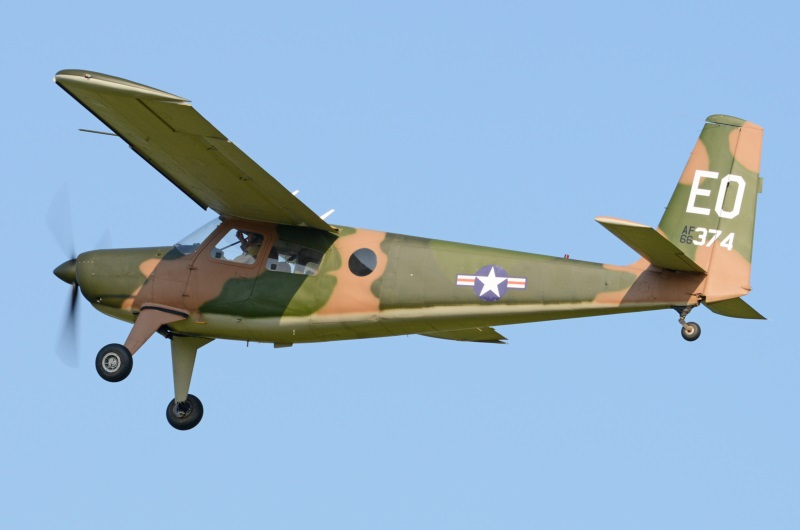
The powerplant was a Lycoming GO-480-G1D6 air-cooled flat-six geared engine with 220 kW (295 HP). There was a 114-liter (30 US gallon) bladder tank in the inner wing, and an option for two more tanks of the same size, giving total capacity of 455 liters (120 US gallons). Ferry tanks could also be fitted, for a total capacity of 1,023 liters (270 US gallons). There were six seats total, the rear pair being a sling seat, the others typically bucket seats. There was a door to the left of the pilot, another door on the right of the middle row of seats, both doors being forward-hinged. It appears an upward-hinged cargo door behind the pilot door was optional.
___________________________________________________________________
HELIO H-295 SUPER COURIER:
___________________________________________________________________
wingspan:
11.89 meters (39 feet)
wing area:
21.5 sq_meters (231 sq_feet)
length:
9.45 meters (31 feet)
height:
2.69 meters (8 feet 10 inches)
empty weight:
945 kilograms (2,080 pounds)
normal loaded weight:
1,540 kilograms (3,400 pounds)
max speed, sea level:
290 KPH (170 MPH / 150 KT)
cruise speed:
130 KPH (80 MPH / 70 KT)
service ceiling:
6,250 meters (20,500 feet)
range, 455 liters fuel:
1,760 kilometers (1,380 miles / 950 NMI)
___________________________________________________________________
In 1974, near the end of the production life of the Courier, Helio introduced the "HT-295 Trigear Courier" -- like the H-295, but with tricycle landing gear.
More than one-third of 528 Helios built were obtained for military service. The US military was very interested in the Courier, since it was ideal for bush warfare. The US Army obtained one H-391 Courier as the "YL-24", while the USAF obtained three H-395 Couriers as the "L-28A". They were redesignated "U-10A" when the Pentagon adopted a common designation scheme in 1962. The "U-10B" was the same, with twice the fuel capacity -- 455 liters (120 US gallons). The "U-10D" -- no "U-10C" ever flew -- was an H-295 in military colors. Couriers were also flown by the CIA during the Vietnam War.
From 1968, Helio built 7 "Twin Couriers", with dual Lycoming O-540 engines, a snubbed nose, a swept tailfin with a forward fillet, and optional wingtip tanks. They were apparently built as a special order for the CIA, and operated in Southeast Asia. The company also produced 18 "HST-550 Stallion" machines, the Stallion being a larger turboprop derivative of the Courier, with a PT6A-27 engine providing 545 skW (680 SHP), a swept tailfin, and backwards-raked landing gear. The Stallion was 12.07 meters (39 feet 7 inches) long, had a wingspan of 12.5 meters (41 feet), and an empty weight of 1,287 kilograms (2,860 pounds).
The Stallions also saw action in Southeast Asia, being given the military designation of "AU-24A". They had hardpoints under the fuselage and wings for five external stores, plus a three-barreled 20-millimeter M197 cannon firing out the side. It was unsuccessful as a gunship platform, and the lot of them were sold off to Cambodia. There was talk of a twin-turboprop "Twin Stallion", but it didn't happen.
Helio folded up in 1974, with the type certificate for the Courier going from one organization to another. During the 1980s, one of the holders apparently built Couriers with direct-drive Lycoming engines, to replace troublesome and expensive geared engines, plus winglets and composite landing gear. 18 were built, being designated "H-800" and "H-700" -- featuring the Lycoming IO-720-A1B engine with 300 kW (400 HP) and Lycoming TIO-540-J2B with 260 kW (350 HP) engine respectively. A number of Couriers are still flying, primarily as bushplanes, with improvements such as modern instrumentation and a ventral pannier.
BACK_TO_TOP* This document was a bit of a scavenger hunt, with details picked up from online sources, backed up by my collection of JANES ALL THE WORLD'S AIRCRAFT volumes. Data on the Helio Stallion is particularly sketchy, which is why discussion of it was reduced to a footnote.

* Illustrations credits:
* Revision history:
v1.0.0 / 01 jul 23 v1.0.1 / 01 jul 25 / Review & polish. (*)BACK_TO_TOP
